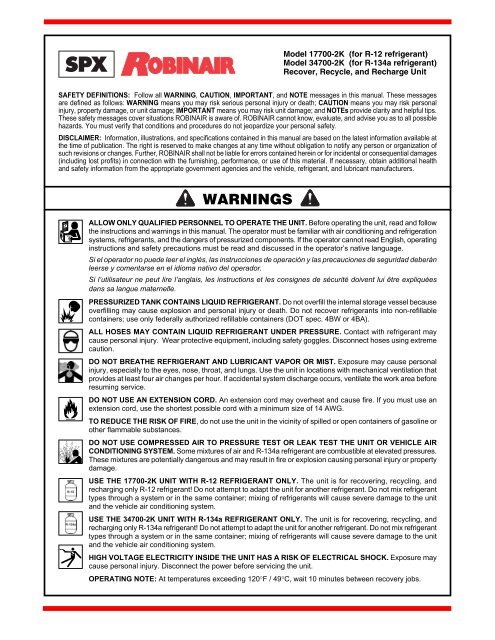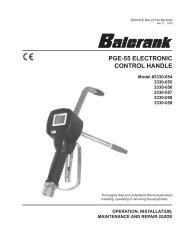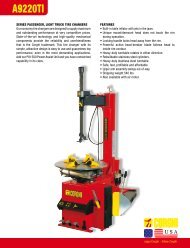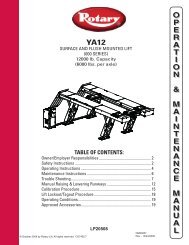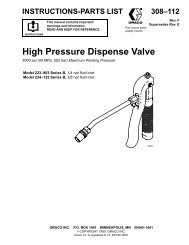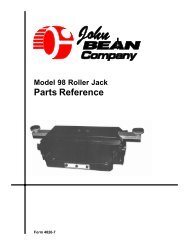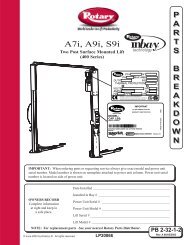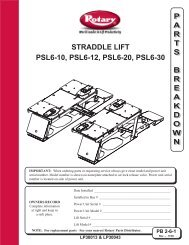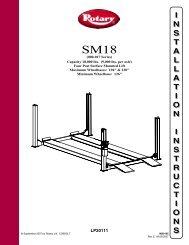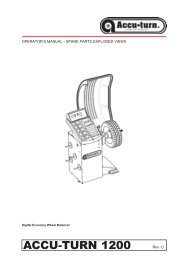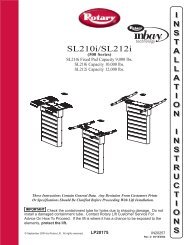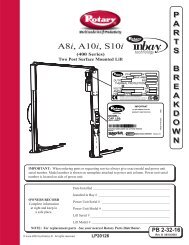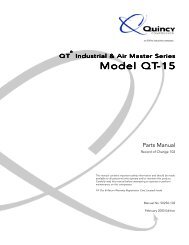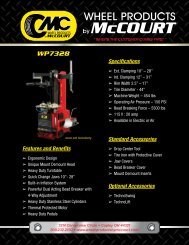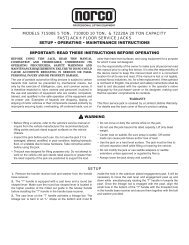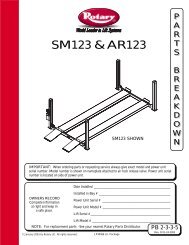Robinair 34700-2K 134a Recovery Unit - NY Tech Supply
Robinair 34700-2K 134a Recovery Unit - NY Tech Supply
Robinair 34700-2K 134a Recovery Unit - NY Tech Supply
Create successful ePaper yourself
Turn your PDF publications into a flip-book with our unique Google optimized e-Paper software.
SAFETY DEFINITIONS: Follow all WARNING, CAUTION, IMPORTANT, and NOTE messages in this manual. These messages<br />
are defined as follows: WARNING means you may risk serious personal injury or death; CAUTION means you may risk personal<br />
injury, property damage, or unit damage; IMPORTANT means you may risk unit damage; and NOTEs provide clarity and helpful tips.<br />
These safety messages cover situations ROBINAIR is aware of. ROBINAIR cannot know, evaluate, and advise you as to all possible<br />
hazards. You must verify that conditions and procedures do not jeopardize your personal safety.<br />
DISCLAIMER: Information, illustrations, and specifications contained in this manual are based on the latest information available at<br />
the time of publication. The right is reserved to make changes at any time without obligation to notify any person or organization of<br />
such revisions or changes. Further, ROBINAIR shall not be liable for errors contained herein or for incidental or consequential damages<br />
(including lost profits) in connection with the furnishing, performance, or use of this material. If necessary, obtain additional health<br />
and safety information from the appropriate government agencies and the vehicle, refrigerant, and lubricant manufacturers.<br />
WARNINGS<br />
Model 17700-<strong>2K</strong> (for R-12 refrigerant)<br />
Model <strong>34700</strong>-<strong>2K</strong> (for R-<strong>134a</strong> refrigerant)<br />
Recover, Recycle, and Recharge <strong>Unit</strong><br />
ALLOW ONLY QUALIFIED PERSONNEL TO OPERATE THE UNIT. Before operating the unit, read and follow<br />
the instructions and warnings in this manual. The operator must be familiar with air conditioning and refrigeration<br />
systems, refrigerants, and the dangers of pressurized components. If the operator cannot read English, operating<br />
instructions and safety precautions must be read and discussed in the operator’s native language.<br />
Si el operador no puede leer el inglés, las instrucciones de operación y las precauciones de seguridad deberán<br />
leerse y comentarse en el idioma nativo del operador.<br />
Si l’utilisateur ne peut lire l’anglais, les instructions et les consignes de sécurité doivent lui être expliquées<br />
dans sa langue maternelle.<br />
PRESSURIZED TANK CONTAINS LIQUID REFRIGERANT. Do not overfill the internal storage vessel because<br />
overfilling may cause explosion and personal injury or death. Do not recover refrigerants into non-refillable<br />
containers; use only federally authorized refillable containers (DOT spec. 4BW or 4BA).<br />
ALL HOSES MAY CONTAIN LIQUID REFRIGERANT UNDER PRESSURE. Contact with refrigerant may<br />
cause personal injury. Wear protective equipment, including safety goggles. Disconnect hoses using extreme<br />
caution.<br />
DO NOT BREATHE REFRIGERANT AND LUBRICANT VAPOR OR MIST. Exposure may cause personal<br />
injury, especially to the eyes, nose, throat, and lungs. Use the unit in locations with mechanical ventilation that<br />
provides at least four air changes per hour. If accidental system discharge occurs, ventilate the work area before<br />
resuming service.<br />
DO NOT USE AN EXTENSION CORD. An extension cord may overheat and cause fire. If you must use an<br />
extension cord, use the shortest possible cord with a minimum size of 14 AWG.<br />
TO REDUCE THE RISK OF FIRE, do not use the unit in the vicinity of spilled or open containers of gasoline or<br />
other flammable substances.<br />
DO NOT USE COMPRESSED AIR TO PRESSURE TEST OR LEAK TEST THE UNIT OR VEHICLE AIR<br />
CONDITIONING SYSTEM. Some mixtures of air and R-<strong>134a</strong> refrigerant are combustible at elevated pressures.<br />
These mixtures are potentially dangerous and may result in fire or explosion causing personal injury or property<br />
damage.<br />
USE THE 17700-<strong>2K</strong> UNIT WITH R-12 REFRIGERANT ONLY. The unit is for recovering, recycling, and<br />
recharging only R-12 refrigerant! Do not attempt to adapt the unit for another refrigerant. Do not mix refrigerant<br />
types through a system or in the same container; mixing of refrigerants will cause severe damage to the unit<br />
and the vehicle air conditioning system.<br />
USE THE <strong>34700</strong>-<strong>2K</strong> UNIT WITH R-<strong>134a</strong> REFRIGERANT ONLY. The unit is for recovering, recycling, and<br />
recharging only R-<strong>134a</strong> refrigerant! Do not attempt to adapt the unit for another refrigerant. Do not mix refrigerant<br />
types through a system or in the same container; mixing of refrigerants will cause severe damage to the unit<br />
and the vehicle air conditioning system.<br />
HIGH VOLTAGE ELECTRICITY INSIDE THE UNIT HAS A RISK OF ELECTRICAL SHOCK. Exposure may<br />
cause personal injury. Disconnect the power before servicing the unit.<br />
OPERATING NOTE: At temperatures exceeding 120°F / 49°C, wait 10 minutes between recovery jobs.


